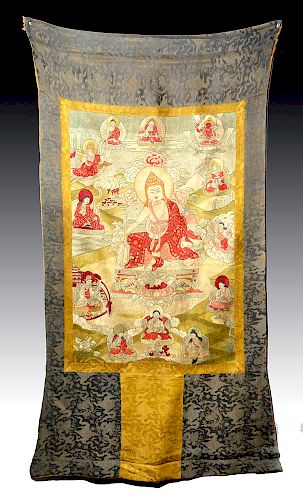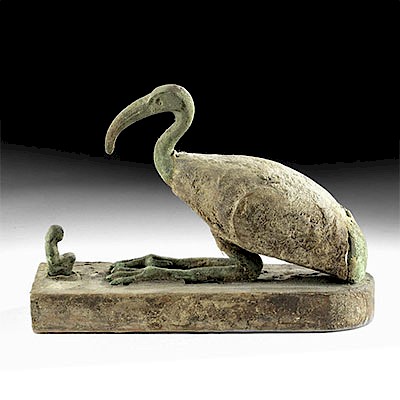19th C. Tibetan Embroidered Silk Thangka - Tsongkhapa
Lot 137
About Seller
Artemis Gallery
686 S Taylor Ave, Ste 106
Louisville, CO 80027
United States
Selling antiquities, ancient and ethnographic art online since 1993, Artemis Gallery specializes in Classical Antiquities (Egyptian, Greek, Roman, Near Eastern), Asian, Pre-Columbian, African / Tribal / Oceanographic art. Our extensive inventory includes pottery, stone, metal, wood, glass and textil...Read more
Estimate:
$3,000 - $4,500
Absentee vs Live bid
Two ways to bid:
- Leave a max absentee bid and the platform will bid on your behalf up to your maximum bid during the live auction.
- Bid live during the auction and your bids will be submitted real-time to the auctioneer.
Bid Increments
| Price | Bid Increment |
|---|---|
| $0 | $25 |
| $300 | $50 |
| $1,000 | $100 |
| $2,000 | $250 |
| $5,000 | $500 |
| $10,000 | $1,000 |
| $20,000 | $2,500 |
| $50,000 | $5,000 |
| $100,000 | $10,000 |
| $200,000 | $20,000 |
About Auction
By Artemis Gallery
Oct 31, 2019
Set Reminder
2019-10-31 10:00:00
2019-10-31 10:00:00
America/New_York
Bidsquare
Bidsquare : Fine Antiquities, Asian, Ethnographic Art
https://www.bidsquare.com/auctions/artemis-gallery/fine-antiquities-asian-ethnographic-art-4581
Our Halloween Day auction features classical antiquities, ancient and ethnographic art from cultures encompassing the globe, plus fine art. Artemis Gallery info@artemisgallery.com
Our Halloween Day auction features classical antiquities, ancient and ethnographic art from cultures encompassing the globe, plus fine art. Artemis Gallery info@artemisgallery.com
- Lot Description
Tibet, ca. 19th century CE. A striking thangka, fully embroidered in fine silk threads of red, gold, pink, green, black, and cream hues, to honor the Lama Tsongkhapa (1357-1419), a 15th century saint and scholar of Tibet who was the founder of the Gelug Order, surrounded by a sacred ensemble including various Buddhas of the past. Tsongkhapa's abhorrence of the laxity of many monastic orders gave rise to a strong foundation for the Order of the Virtuous, the Gelugpa. Since the Gelugpas wore yellow hats, this order is sometimes referred to as the Yellow Hats, distinguishing it from other orders called Red Hats. Tsongkhapa is known for restoring monastic discipline, the prohibition of the use of alcohol, and requiring strict celibacy as well as a regimented daily schedule. His honorary title is Je Rinpoche -Je meaning "exalted". Size: central image 29.5" L x 19.5" W (74.9 cm x 49.5 cm); with borders 52" L x 26.5" W (132.1 cm x 67.3 cm)
According to Meulenbeld's "Buddhist Symbolism in Tibetan Thangkas (2004): "Tsongkhapa was born of poor parents in Amdo, Eastern Tibet, in the Onion Valley. His keen intelligence was evident when he was little. At a young age, he received various degrees from his studies in Central Tibet where he mastered five main subjects taught by a Tibetan monastery university: abhidharma (metaphysics), madhyamika (the Middle Way, between Being and Non-Being), prajnaparamita (knowledge), pramana (logic), and vinaya (monastic rules) . . . Tsongkhapa founded large monasteries and universities, such as Ganden, Drepung, and Sera."
Due to the vow of celibacy, hereditary succession was not possible. The solution was to designate a new monastery abbot or lama as an incarnation of his predecessor. From this arose the succession to Yellow Hats leadership, the Dalai Lama who is regarded as an incarnation of Avalokiteshvara. This line of Dalai Lamas began in the 16th century. Following his death, Tsongkhapa was retroactively named the first Dalai Lama.
Examples like this were created to hang in the grand hall of monasteries. The iconography illustrates how throughout his previous lives, Je Tsongkhapa cultivated his path toward Enlightenment and how his spiritual progression was confirmed by prophesies of the Buddhas of the past.
Provenance: ex-Bricker collection, USA; acquired in Beijing 2003
All items legal to buy/sell under U.S. Statute covering cultural patrimony Code 2600, CHAPTER 14, and are guaranteed to be as described or your money back.
A Certificate of Authenticity will accompany all winning bids.
We ship worldwide and handle all shipping in-house for your convenience.
#119214Openings for dowels to be placed at upper and lower ends. Only minor fraying at upper ends near these openings. Otherwise excellent.Condition
- Shipping Info
-
All shipping is handled in-house for your convenience. Your invoice from Artemis Gallery will include shipping calculation instructions. If in doubt, please inquire BEFORE bidding for estimated shipping costs for individual items.
-
- Buyer's Premium



 EUR
EUR CAD
CAD AUD
AUD GBP
GBP MXN
MXN HKD
HKD CNY
CNY MYR
MYR SEK
SEK SGD
SGD CHF
CHF THB
THB

















